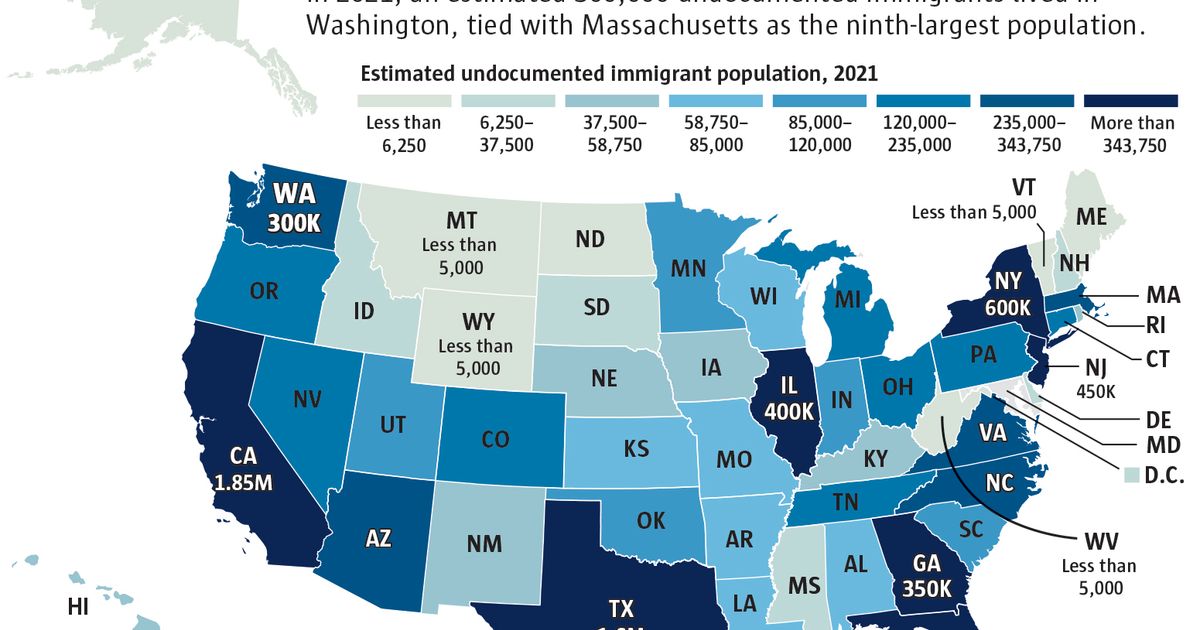Illegal immigration is on the rise in Washington, according to a new study — and that’s not the case in the nation as a whole. We’re one of just two states to see an increase.
From 2017 to 2021, Washington’s population of undocumented immigrants increased by about 60,000, according to a report from the Pew Research Center, which based its estimates on data from the U.S. Census Bureau. Florida was the other state to see a significant increase, up about 80,000.
Only two states experienced a major decline in the population of undocumented immigrants in this period: California, with a decrease of about 150,000, and Nevada, down 25,000.
All other states had roughly the same number. In total, 10.5 million undocumented immigrants were in the U.S. in 2021, unchanged from 2017.
The Pew report notes the new estimates do not reflect changes in undocumented immigration reflected by the drastic increase in apprehensions and expulsions of migrants along the U.S.-Mexico border since 2021.
Undocumented immigrants in Washington totaled about 300,000 in 2021, tying Massachusetts as the ninth-highest among the states. California had the largest number, at 1.85 million, followed by Texas (1.6 million) and Florida (900,000). Montana, Wyoming, West Virginia and Vermont had the smallest, each at fewer than 5,000 people.
About 34% of undocumented immigrants in Washington in 2021 — about 102,000 people — were from Mexico, more than any single country. Nationally, people from Mexico accounted for 39% of the nation’s undocumented immigrants, or 4.05 million in 2021. That’s down by nearly 900,000 from 2017.
The decrease reflects several factors, according to Pew. There has been a broader decline in migration from Mexico to the United States, and an increasing number of Mexican immigrants to the U.S. have returned to Mexico. Additionally, more opportunities are available for lawful migration, especially for temporary agricultural workers.
But while the number of undocumented immigrants from Mexico has fallen, the number from other parts of the world has risen. The biggest increase has been from Central America, up 240,000 from 2017 to 2021, followed by Asia and Europe/Canada, both up 180,000.
Many undocumented immigrants in the workforce come into the United States legally. This is particularly true of immigrants from Asia. They might come over on a tourist, student or work visa but then remain in the country after the visa has expired.
In Washington, about 220,000 undocumented immigrants were in the labor force in 2021, representing 5.6% of the state’s total labor force, according to Pew. That’s higher than the U.S. average of 4.6%.
Most undocumented immigrants who work in Washington are employed in white-collar occupations, which is not typical. In fact, among the 17 states with at least 100,000 undocumented immigrants in the workforce, Washington is the only one where most work in white-collar occupations. In the other states, most work in service or construction jobs.
In Washington, the industry with the largest number of undocumented immigrants is business services, made up of companies that provide professional, scientific and technical support to organizations operating in other industries.
Washington’s 300,000 undocumented immigrants represented 3.9% of the state’s population in 2021, which tied with Connecticut as the eight-highest percentage. Nevada had the highest percentage of any state, at 5.9%, followed by Texas (5.4%) and New Jersey (4.8%).
Undocumented immigrants represented about one-quarter of the people in Washington who are foreign-born in 2021. It is a group that has grown significantly in recent decades.
Pew’s data shows Washington had 40,000 undocumented immigrants in 1990. That number increased rapidly over the next 15 years, hitting 240,000 in 2005. After that, there wasn’t much change until 2018, when the undocumented-immigrant population jumped to 300,000, where the new analysis indicates it remained through 2021.

